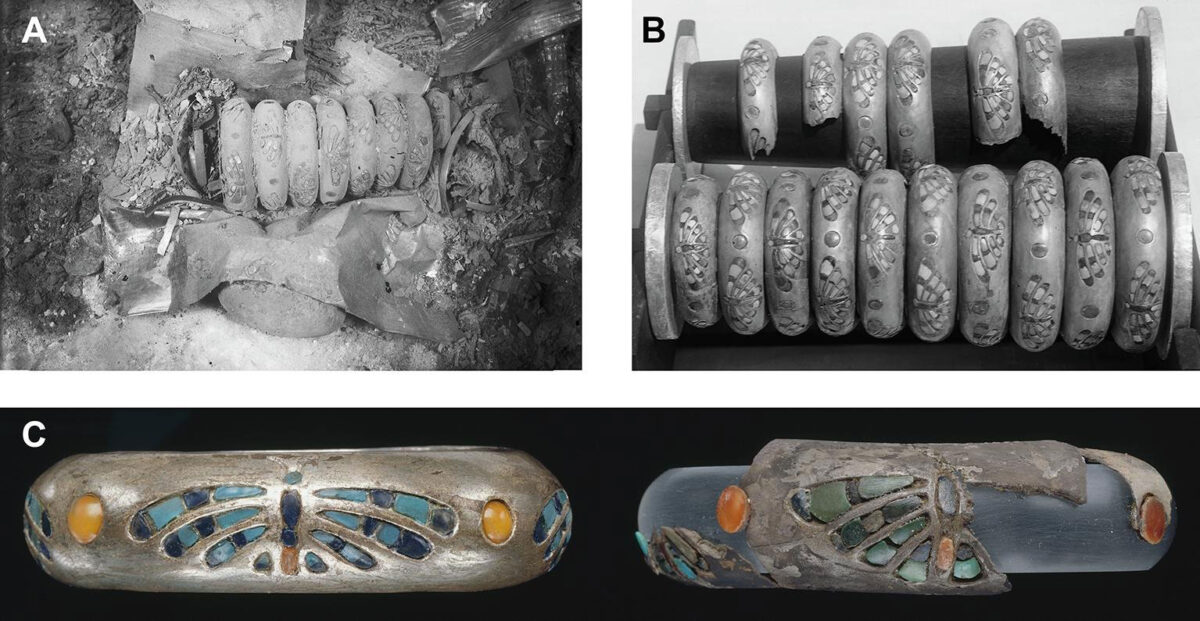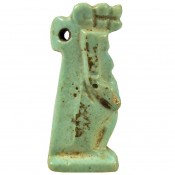Modern-day Greece has been shown to be the source of silver used in the spectacular bracelets of Queen Hetepheres, the mother of Pharaoh Khufu, suggesting that trade between Egypt and the Aegean was going stronger than expected during the Pyramid Age.
The group of bracelets found in the intact tomb of Queen Hetepheres I, the wife of Sneferu and mother of Khufu (c. 2589–2566 BC), of the 4th Dynasty, represent the largest and most famous collection of silver artifacts from early Egypt. As silver is rarely found in the Egyptian archaeological record until the Middle Bronze Age, the bracelets are a statement of royal privilege. Inscription on their box indicates they stood for a standard value as a commodity, while they highlight access to a highly exclusive network providing Egyptian artisans with precious minerals, including silver. With Egypt lacking domestic silver ore sources, experts had proposed that the Queen’s silver might have been partitioned from specific silver-rich gold ores, or it would have been imported from Byblos, in modern-day Lebanon. Still, the bracelets had not been recently analyzed, so each of these theories remained unproven.
Now, a team of experts led by Karin Sowada (Department of History and Archaeology, Macquarie University, Sydney, Australia), analyzed samples of corroded bracelets from the collection, which are now kept in the Museum of Fine Arts, Boston, and published their finds in the Journal of Archaeological Science: Reports. According to the article’s abstract, the team used bulk XRF, micro-XRF, SEM-EDS, X-ray diffractometry, and MC-ICP-MS to obtain elemental and mineralogical compositions and lead isotope ratios, to understand the nature and metallurgical treatment of the metal and identify the possible ore source. It was found that the pieces consist of silver with traces of copper, gold, lead, and other elements. The minerals are silver, silver chloride, and a possible trace of copper chloride.
The source of silver (Ag) ores may be traced by examining lead (Pb) isotope ratios in the sample. Researchers actually compared the lead isotope composition of a sample, with those from a galena (PbS) database that included some 7000 localities located between the Atlantic Ocean and Iran. What came by surprise was that the lead isotope ratios are consistent with ores from the Cyclades (Aegean islands, Greece), and to a lesser extent from Lavrion (Attica, Greece), and were not partitioned from gold or electrum as previously proposed. As it is stated in the article, “Although similarities in Pb isotope composition occur in unlikely sources such as Samos and Tunisia, which are not known for Ag production, the most significant ‘hits’ are from the Cyclades (Seriphos, which has more hits, Anafi, and Kea-Kythnos), and to a lesser from the Lavrion mines (district of Attica in central Greece). Anatolia, which has been suggested for the origin of Bronze Age copper-alloy artefacts on multiple occasions can be, in the limits of ore data availability, excluded from consideration as a source.”.
Historical sources tell of the import of silver in Egypt during the reign of Hetepheres’ husband, Sneferu, but the origins are not documented. Interconnections between Old Kingdom Egypt and silver-producing areas in the Taurus mountains and particularly Byblos, in Lebanon, are later, dating to the 6th Dynasty. At the same time, Egyptian stone vessels and other early and mid-Old Kingdom objects are recorded from Crete, while silver mines of Lavrion in Attica were evidently exploited at the time, although direct evidence in support of this region’s contacts with Egypt is lacking. As for the Cyclades, ongoing research at Sifnos, Serifos, and Kythnos gradually brings to light evidence of intense metallurgical activity. What is already evident, from Egypt’s side, is that the results provide new insights about silver ore sources, commodity exchange networks, and metallurgy in Egypt during the Early Bronze Age.
“This new finding demonstrates, for the first time, the potential geographical extent of commodity procurement networks utilized by the Egyptian state during the early Old Kingdom at the height of the Pyramid-building age”, concludes the article.





